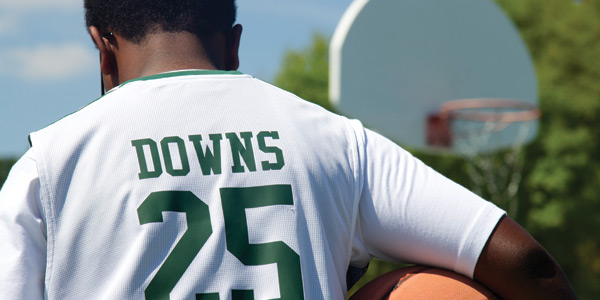 When 10-year-old Keshawn Downs was sidelined from playing on his Police Athletic League basketball team late last year, it wasn’t because of a sprained ankle or unsatisfactory report card. It was because the athletic, basketball-loving fifth-grader from Don Brewer Elementary School in Arlington was diagnosed with an aneurysm in his brain.
When 10-year-old Keshawn Downs was sidelined from playing on his Police Athletic League basketball team late last year, it wasn’t because of a sprained ankle or unsatisfactory report card. It was because the athletic, basketball-loving fifth-grader from Don Brewer Elementary School in Arlington was diagnosed with an aneurysm in his brain.
Around Thanksgiving, Keshawn started having headaches, nausea and got a stiff neck, so his parents took him to see the doctor, which prompted a trip to Wolfson Children’s Emergency Center. After a few hours and diagnostic tests, pediatric neurosurgeons located the aneurysm in Keshawn’s brain that had ruptured, fortunately with minimal damage.
“We thought he’d just slept wrong or was coming down with the flu,” said Keshawn’s mother, Jessica Downs. “When they came in and told us what it was, I felt like I had been hit with a ton of bricks.”
Aneurysms are not rare, but in children, they are very uncommon, accounting for only five percent of cases in the general population. When they occur, they are often lethal. About 40 percent of people who suffer a ruptured aneurysm die before ever reaching a hospital.
Thankfully, the pediatric emergency physician on duty the afternoon Keshawn came to Wolfson Children’s had the  experience that led him to sense there was something about Keshawn’s case that warranted further testing and ordered a CT scan. The results of that test lead to a magnetic resonance angiogram (MRA), which showed a probable aneurysm. It had leaked blood into his spinal fluid, which was causing the pain and stiffness in his neck. That’s when pediatric neurosurgeons stepped in to pinpoint its precise location.
experience that led him to sense there was something about Keshawn’s case that warranted further testing and ordered a CT scan. The results of that test lead to a magnetic resonance angiogram (MRA), which showed a probable aneurysm. It had leaked blood into his spinal fluid, which was causing the pain and stiffness in his neck. That’s when pediatric neurosurgeons stepped in to pinpoint its precise location.
“We performed an angiogram which located a small, 1.5 millimeter bulge in Keshawn’s right interior carotid artery,” said Ricardo A. Hanel, MD, an endovascular neurosurgeon with Lyerly Neurosurgery at Baptist Health and with Wolfson Children’s Hospital. “Because of its shape, size and location, we decided that open surgery was the best repair option for him.”
Together with University of Florida College of Medicine – Jacksonville pediatric neurosurgeon Philipp Aldana, MD, medical director of the Lucy Gooding Children’s Neurosurgery Center and co-director of the Wolfson Children’s Hospital Neuroscience Institute, Dr. Hanel performed a pterional craniotomy, opening the top of Keshawn’s skull above the right eye to gain access to the ruptured bulge that was slowly hemorrhaging on the blood vessel. They then clipped the vessel with a titanium clamp, which pinched the walls together and stopped the leak. Blood vessels, like roads, come to a fork and if there’s a weak spot, and a bulge can sometimes develop. In his case, the bulge was not stable, and had it not been clamped in time, the bleeding would have caused more damage to surrounding brain cells, an increase in pressure in the brain, and a reduction in its blood and oxygen supply.
“We prayed, and after several hours they came out and told us that the aneurysm had fully ruptured right before their eyes as they were clamping it,” Jessica said. “If Keshawn had been on the playground playing basketball when that happened, he would not be with us today.”
Immediately after the three-hour surgery, Keshawn was admitted back to the Pediatric Intensive Care Unit, where he was closely monitored for more than a week. For the next two weeks, he was given medications every four hours to prevent seizures and clotting. When a hemorrhage happens in the space between the brain and its surrounding tissues, inflammation is triggered that can cause cognitive impairment such as short-term memory loss, attention problems, strokes and seizures. Because the aneurysm was caught in time and younger brains recover better, Dr. Hanel and Dr. Aldana agree that Keshawn’s prognosis is very good.
“For Keshawn, it’s a cure, but we’ll keep a close eye on his blood vessels because it’s possible to develop new aneurysms elsewhere,” Dr. Hanel said. “He’ll be back in three months, and then in another six, we’ll take a scan to see if the aneurysm is completely gone.”
Aside from some minor stuttering, Keshawn is doing well, and in early February received the go-ahead from his pediatric medical and surgical team to rejoin the Warriors, his PAL basketball team. He even got the ‘okay’ to ride on a roller coaster, which prompted his parents Larry and Jessica to take him to Disney World at the end of February.
“Even in the rain, he really had a blast,” Jessica said.
“Although it’s a rare condition in children, aneurysms have a very high mortality rate,” Dr. Aldana said. “We have the specialty care at the Wolfson Children’s Hospital Neuroscience Institute that’s required to properly address these life-threatening neurological events.”
It is excellent work, provided by an exceptional staff, that gives patients like Keshawn a definite home court advantage.

Written by Wolfson Children’s Hospital/Baptist Health
Photography by Amanda Callender












